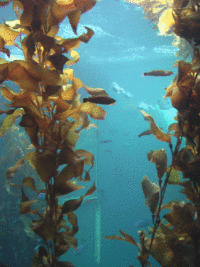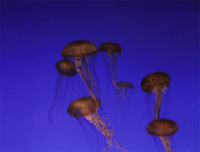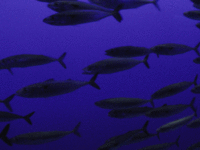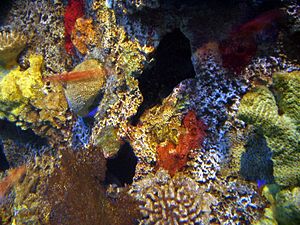Marine biology: Difference between revisions
imported>Michael Nishizaki No edit summary |
imported>Chris Day No edit summary |
||
| Line 1: | Line 1: | ||
{{subpages}} | |||
'''Marine biology''' is the scientific study of the [[plant]]s, [[animal]]s and other organisms that live in the earth's [[ocean]], seas, and related salt-water environments. Marine biologists are concerned not just with individual types of animals, but also with their inter-relationships with each other and their habitat. | '''Marine biology''' is the scientific study of the [[plant]]s, [[animal]]s and other organisms that live in the earth's [[ocean]], seas, and related salt-water environments. Marine biologists are concerned not just with individual types of animals, but also with their inter-relationships with each other and their habitat. | ||
Revision as of 23:27, 14 October 2007
Marine biology is the scientific study of the plants, animals and other organisms that live in the earth's ocean, seas, and related salt-water environments. Marine biologists are concerned not just with individual types of animals, but also with their inter-relationships with each other and their habitat.
There are many practical reasons to study marine biology. Marine life represents a vast resource, providing food, medicine, and raw materials, in addition to helping to support recreation and tourism all over the world. At a fundamental level, marine life helps determine the very nature of our planet. Marine organisms produce much of the oxygen we breathe and probably help regulate the earth's climate. Shorelines are in part shaped and protected by marine life, and some marine organisms even help create new land.
Overview
The species of organisms that are studied by marine biologists are extraordinarily diverse. In size, they range from the microscopic to the enormous. Genera that are too tiny to be seen without magnification include the plankton and phytoplankton, which can be as small as 0.02 micrometers, but are hugely important as the primary producers of the sea. The marine giants include cetaceans (whales), which reach up to a reported 33 meters (109 feet) in length. The blue whale is the largest single living organism on earth in our time.
The salt-water habitats studied by marine biology are as diverse as the species, including everything from the tiny layers of surface water, in which organisms and abiotic items may be trapped in surface tension between the ocean and atmosphere, to the depths of the abyssal trenches, sometimes 10,000 meters or more beneath that surface, where darkness is constant and pressure so extreme that only creatures with special adaptations can survive. Marine habitats also include the coral reefs, kelp forests, tidepools, muddy, sandy, and rocky bottoms, and the open ocean (pelagic) zone, where solid objects are rare and the surface of the water is the only visible boundary.
Biologists agree that a large proportion of all life on Earth exists in the oceans, although exactly how large that proportion is remains unknown. While the oceans comprise about 71% of the Earth's surface, their great depths provide the marine habitat 300 times the volume of the terrestrial habitats on Earth.
Many species are economically important to humans, including the food fishes. It is also becoming understood that marine ecology affects the land, and therefore influences the quality of human habitats. Life in the sea plays an important role in the maintenance of earth's mineral supplies (such as the carbon cycle), of air quality (such as Earth's respiration, and in the movement of energy through the food chain in many ecosystems.
Large areas beneath the ocean surface still remain effectively unexplored.
Subfields
The marine ecosystem is large, and thus there are many subfields of marine biology. Most involve studying specializations of particular species (i.e., phycology, invertebrate zoology, ichthyology).
Other subfields study the physical effects of continual immersion in sea water and the ocean in general, adaptation to a salty environment, and the affects of changing various oceanic properties on marine life. A subfield of marine biology studies the relationships between oceans and ocean life, and global weather and environmental issues (such as carbon dioxide displacement).
Recent marine biotechnology has focused largely on marine biomolecules, especially proteins, that may have uses in medicine or engineering. Marine environments are the home to many exotic biological materials that may inspire biomimetic materials.
An interesting branch of marine biology is aquaculture; which some countries do a lot of in the oceans, especially Japan.
Related fields
Marine biology is closely linked to both oceanography and biology. It also encompasses ideas from ecology. Fisheries science and marine conservation can be considered partial offshoots of marine biology.
Lifeforms
Microscopic life
Microscopic life undersea is incredibly varied and still poorly understood. For example, the role of viruses in marine ecosystems is barely being explored even in the beginning of the 21st century.
The role of phytoplankton is better understood due to their critical position as the most numerous primary producers on Earth. Phytoplankton are categorized into cyanobacteria (also called blue-green algae/bacteria), various types of algae: red, green, brown, and yellow-green, diatoms, dinoflagellates, euglenoids, coccolithophorids, cryptomonads, crysomonads, chloromonads, prasinomonads, and silicoflagellates.
Zooplankton tend to be somewhat larger, and not all are microscopic. Many Protozoa are zooplankton, including dinoflagellates, zooflagellates, foraminiferans, and radiolarians. Some of these (such as dinoflaggelates) are also phytoplankton; the plant/animal distinction often breaks down in very small organisms. Other zooplankton include cnidarians, ctenophores, chaetognaths, molluscs, arthropods, urochordates, and annelids such as polychaetes. Many larger animals begin their life as zooplankton before they become large enough to take their familiar forms. Two examples are fish larvae and sea stars (also called starfish).
Plants and algae
Most of the niches occupied by plants on land are occupied by macroscopic algae in the ocean, which are commonlly known as seaweeds. Most macroscopic marine algae fall into one of three groups: 1). Rhodophyta (red algae); 2). Phaeophyta (brown algae including kelp) or; 3). Chlorophyta (green algae). Higher plants represent < 0.5% of the marine flora [1] and are often found in shallow waters. All true marine plants are angiosperms and of polyphyletic origin (evolved separately in different places in the phylogenetic tree)[2].
In the ocean, flowering plants are represented by the seagrasses (examples of which are eelgrass, Zostera, and turtlegrass, Thalassia). These plants have adapted to the high salinity of the ocean environment. The intertidal zone is also a good place to find plant life in the sea, where mangroves or cordgrass or beach grass might grow.
Marine invertebrates
As on land, invertebrates make up a huge proportion of all life in the sea. Invertebrate sea life includes Cnidaria such as Jellyfish and sea anemone; Ctenophora; sea worms including phyla: Plathyhelminthes, Nemertea, Annelida, Sipuncula, Echiura, and the Phoronida; Mollusca including shellfish, squid, octopus; Crustaceans including crabs, shrimp and barnacles ; Porifera including sponges, Bryozoa, Echinodermata including sea urchins and sea stars; and Urochordata - sea squirts or tunicates.
Fish
Fishes have evolved very different biological functions from other large organisms. Fish anatomy includes a two-chambered heart, operculum, secretory cells that produce mucous, swim bladder, scales, fins, lips and eyes. Fish breathe by extracting oxygen from water through their gills. Fins propel and stabilize the fish in the water.
Well known fish include: sardines, anchovy, tuna, clownfish (also known as anemonefish), and bottom fish which include halibut and ling cod. Predators include sharks and barracuda.
Marine mammals
There are five main types of marine mammals.
- Cetaceans include toothed whales (Suborder Odontoceti), such as the Sperm Whale, dolphins, and porpoises. Cetaceans also include baleen whales (Suborder Mysticeti), such as Gray Whales, Humpback Whales, Dall's porpoise, and Blue Whales.
- Sirenians include manatees, the Dugong, and the extinct Steller's Sea Cow.
- Seals (Family Phocidae), sea lions (Family Otariidae - which also include the fur seals), and the Walrus (Family Odobenidae) are all considered pinnipeds.
- Sea Otters are members of the Family Mustelidae, which includes weasels and badgers.
- Finally, Polar Bears (Family Ursidae) are sometimes considered marine mammals because of their dependence on the sea.
Reefs
Reefs comprise some of the densest and most diverse habitats in the world. The best-known types of reefs are tropical coral reefs which exist in most tropical waters; however, reefs can also exist in cold water. Reefs are built up by corals and other calcium-depositing animals, usually on top of a rocky outcrop on the ocean floor. Reefs can also grow on other surfaces, which has made it possible to create artificial reefs. Coral reefs also support a huge community of life, including the corals themselves, their symbiotic zooxanthellae, tropical fish and many other organisms.
Much attention in marine biology is focused on coral reefs and the El Niño weather phenomenon. In 1998, coral reefs experienced a "once in a thousand years" bleaching event, in which vast expanses of reefs across the Earth died because sea surface temperatures rose well above normal. Some reefs are recovering, but scientists say that 58% of the world's coral reefs are now endangered and predict that global warming could exacerbate this trend.
Deep sea and trenches
The ocean is deep, very deep in some places. The deepest recorded measure to date is the Mariana Trench, near the Philippines, in the Pacific Ocean at 10924 m (35838 ft). At such depths, water pressure is extreme and there is no sunlight, but some life still exists. Small flounder (family Soleidae) fish and shrimp were seen by the American crew of the bathyscaphe Trieste when it dove to the bottom in 1960.
Other notable oceanic trenches include Monterey Canyon, in the eastern Pacific, the Tonga Trench in the southwest at 10,882 m (35,702 feet), the Philippine Trench, the Puerto Rico Trench at 8605 m (28232 ft), the Romanche Trench at 7760 m (24450 ft), Fram Basin in the Arctic Ocean at 4665 m (15305 ft), the Java Trench at 7450 m (24442 ft), and the South Sandwich Trench at 7235 m (23737 ft).
In general, the deep sea is considered to start at the aphotic zone, the point where sunlight loses its power of transference through the water. Many life forms that live at these depths have the ability to create their own light.
Much life centers on seamounts that rise from the deeps, where fish and other sea life congregate to spawn and feed. Hydrothermal vents in the ocean floor act as oases, as do their opposites, cold seeps. Such places support unique biomes and many new microbes have been discovered at these sights.
Marine biologists are trying to amass a more complete mapping of underwater species with the help of modern techniques. The deepest oceanic depressions are supposed to contain unknown species, possibly also of great potential interest for the theories on evolution.
How oceanic factors affect distribution of various organisms
An active research topic in marine biology is to discover and map the life cycles of various species and where they spend their time. Marine biologists study how the ocean currents, tides and many other oceanic factors affect ocean lifeforms, including their growth, distribution and well-being. This has only recently become technically feasible with advances in GPS and newer underwater visual devices.
Most ocean life breeds in specific places, nests or not in others, spends time as juveniles in still others, and in maturity in yet others. Scientists know little about where many species spent different parts of their life cycles. For example, it is still largely unknown where sea turtles travel. Tracking devices do not work for some life forms, and the ocean is not friendly to technology. But these factors are being overcome in many instances.
Famous marine biologists

- Jakob Johan Adolf Appellöf (1857-1921), Swedish marine zoologist.
- Joseph Ayers, marine neurophysiologist and biomimetic researcher.
- Samuel Stillman Berry (1887-1984), U.S. marine zoologist.
- Henry Bryant Bigelow (1879–1967), U.S. marine biologist.
- Rachel Carson (1907-1964) American Marine Biologist and Author.
- Ilham Artüz (1924-1993) Turkish Marine Biologist and Oceanographer
- Carl Chun (1852-1914), German marine biologist
- Jacques-Yves Cousteau (1910-1997), French marine biologist and explorer.
- Anton Dohrn (1840-1909), German marine biologist.
- Sylvia Earle (born 1935), American oceanographer.
- Johan Hjort, Norwegian marine zoologist and one of the founders of ICES.
- Bruno Hofer (1861-1916), German fisheries scientist.
- Hirohito, Japanese emperor.
- August David Krohn (1803–1891), Russian/German zoologist.
- William Elford Leach (1790-1836), English zoologist and marine biologist.
- Philip S. Lobel Professor, Boston University Marine Program
- Nicholai Miklukho-Maklai (1846-1888), Russian marine biologist and anthropologist.
- Sir John Murray (1841-1914), Scots- Canadian marine biologist.
- Harald Rosenthal (born 1937), German hydrobiologist known for his work in fish farming and ecology.
- Michael Sars (1809–1869), Norwegian theologian and biologist.
- Georg Sars (1837-1927), Norwegian marine biologist.
- Ruth Turner (1915-2000), marine biologist.
- Robert Paine Professor, emeritus University of Washington intertidal Ecologist
- Charles Wyville Thompson (1832-1882), Scottish marine biologist
References
- ↑ Ackerman, JD 1998. Is the limited diversity of higher plants in marine systems the result of biophysical limitations for reproduction or evolutionary and physiological constraint? Functional Ecology 12: 975–982.
- ↑ Les, D.H., Cleland, M.A. & Waycott, M.A. 1997. Phylogenetic studies in Alismatidae. II. Evolution of marine angiosperms (seagrasses) and hydrophily? Systematic Botany 22: 443-463
See also
External links
- Oceanography Image of the Day, from the Woods Hole Oceanographic Institution
- MarineBio: an evolving online tribute to Marine Biology and all Ocean life.
- Marine Conservation Society: UK charity for seas and wildlife.
- SeaTurtle.org: Tracking a sea turtle.
- Marinebiology.co.uk a marine biology resource.
- Marine Ecology Progress Series (MEPS).
- Marine Biological Association of the United Kingdom.
- Marine Life Information Network for Britain and Ireland - MarLIN.
- Freshwater and Marine Image Bank The Freshwater and Marine Image Bank is an ongoing digital collection of images related to freshwater and marine topics. From the University of Washington Libraries Digital Images Collection
- PISCO - Partnership for Interdisciplinary Studies of Coastal Oceans
- The Marine Environmental Research Institute
- The National Ocean Service
- Wembury Marine Centre



